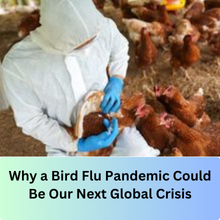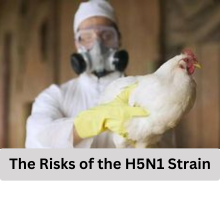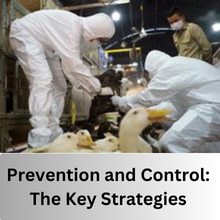
A bird flu pandemic is not just a distant, hypothetical scenario—it’s a very real, foreseeable catastrophe. With the recent rise in bird flu cases and the continual mutation of strains like H5N1, the risk of a global pandemic is growing. Almost five years after the world was shaken by COVID-19, we find ourselves again standing on the edge of another potential crisis. The main difference this time? Luck. Whether or not a bird flu pandemic breaks out in the coming years will depend on a combination of factors that seem all too familiar from our previous pandemic experience.
The Avian Flu’s Current State
The H5N1 strain of avian influenza has been a concern for many years, particularly as it continues to mutate and jump between species. In the U.S., H5N1 has already made its way into the nation’s cattle, infecting about a third of California’s dairy herds. So far, farmworkers have been spared from the worst, as the virus has not yet evolved the ability to spread among humans. However, this situation remains precarious. As flu season intensifies, it’s only a matter of time before the virus might develop the ability to spread more easily, putting human populations at risk.
Understanding Influenza Viruses
Influenza viruses, including avian, swine, and human strains, are particularly dangerous because of their ability to mutate rapidly. Unlike many other viruses, flu viruses can adapt quickly to new species. This means that if a person or animal is infected with both a human flu strain and an avian flu strain at the same time, the two viruses can exchange genetic material, creating new, potentially deadly variants. This is one of the reasons why influenza pandemics have been so devastating in history.
Why a Bird Flu Pandemic is Foreseeable
The threat of a bird flu pandemic is not new. In fact, we’ve seen similar outbreaks in the past, most notably the 1918 influenza pandemic. Historically, flu viruses like H5N1 have been a constant threat due to their ability to evolve and spread across species. With current conditions, including global travel and agricultural practices that bring humans and animals into closer contact, the chances of a bird flu pandemic are higher than ever. This makes it one of the most foreseeable catastrophic events in modern history.
The Risks of the H5N1 Strain
H5N1 is particularly dangerous because it can spread quickly through bird populations, and while it’s not yet capable of widespread human-to-human transmission, it’s only a matter of time before this virus may evolve that ability. Mutations are the key to understanding why H5N1 is so concerning. Every time the virus encounters a new host, there’s a chance it will adapt and find a way to infect humans more effectively. Should that happen, the results could be catastrophic.
The Role of Farmworkers and Livestock in the Spread
Farmworkers, particularly those in regions with large livestock populations, are at a heightened risk of exposure to H5N1. This is because the virus can spread through poultry and other animals, creating a direct connection between livestock and human populations. Despite precautions, farmworkers remain vulnerable, and any lack of protective measures could lead to an outbreak that spreads rapidly. In addition, animals such as pigs can act as intermediaries, further facilitating the mutation and spread of the virus.
Impact of Seasonal Flu on Pandemic Risk
The arrival of flu season only increases the risk of a bird flu pandemic. As temperatures drop and people spend more time indoors, the chances of the virus spreading among humans grow. Cold weather creates perfect conditions for viruses to thrive, and poor indoor ventilation can exacerbate the problem. The overlap between seasonal flu and avian flu creates an opportunity for genetic exchange, where the two viruses could combine to form a new, even more dangerous strain.
Also read: Trump Nominates Chad Chronister as DEA Head – What’s Next?
The Biden Administration’s Response
The U.S. response to pandemic preparedness has been far from perfect. Critics argue that the current administration, despite its experience with COVID-19, has failed to adequately address the threat of avian influenza. From delayed responses to insufficient resources for viral monitoring, the country has not fully prepared for the next viral outbreak. This lack of urgency and action could put the nation at even greater risk.
The Future of U.S. Health Leadership
Looking ahead, there are even more concerns about the U.S. leadership on public health. Robert F. Kennedy Jr., a controversial figure in the world of health policy, has expressed his intention not to prioritize research or vaccine distribution during a pandemic. His stance, combined with his support for raw milk—an acknowledged vector for the spread of H5N1—could exacerbate the situation and hasten the arrival of a pandemic.
Global Readiness for a Bird Flu Pandemic
While the U.S. may be lagging in its preparedness, other countries have started to take more proactive measures. Global collaboration is key to managing pandemics, as viruses know no borders. However, disparities in resources and health infrastructure across different nations make it challenging to build a unified response to bird flu. International cooperation, with a focus on research, vaccine distribution, and early detection, will be essential in preventing the worst-case scenario.
Prevention and Control: The Key Strategies
To mitigate the risk of a bird flu pandemic, early intervention is crucial. This includes rapid identification of new strains, investment in vaccine research, and the implementation of stringent measures to control the spread of H5N1 in animals. Additionally, improving public health systems, providing protective equipment for farmworkers, and increasing public awareness will play an essential role in preventing an outbreak from spiraling out of control.
What the Future Holds
The future of bird flu remains uncertain, but one thing is clear: the possibility of a pandemic is looming. H5N1 continues to evolve, and without proper intervention, the virus could eventually make the jump to human populations. To prevent this, we need to act now—improve surveillance, strengthen health systems, and prepare for the worst while hoping for the best.
Lessons from Past Pandemics
The 1918 influenza pandemic offers valuable lessons for how we respond to current threats. That pandemic, which killed more people than World War I, was caused by an avian flu virus that mutated and spread across species. By studying the mistakes of the past, we can create better strategies for dealing with future outbreaks. Proactive, rather than reactive, measures are the key to avoiding another global catastrophe.
Also read: Is Trader Joe’s Open on Thanksgiving? Find Out Now
Conclusion
The threat of a bird flu pandemic is not a matter of “if” but “when.” With the H5N1 virus continuing to mutate and the world’s public health systems unprepared for such an event, the risk is higher than ever. However, by learning from past pandemics, taking proactive steps to improve global cooperation, and investing in research and prevention, we can still avoid the worst outcomes. The time to act is now—before it’s too late.
FAQs
What is the likelihood of a bird flu pandemic?
The likelihood is increasing due to the H5N1 strain’s mutations and the proximity of humans to infected animals. However, how soon it might happen is uncertain.
How does H5N1 spread?
H5N1 spreads primarily through contact with infected birds or animals, but mutations could allow it to spread between humans.
Can bird flu be transmitted from animals to humans?
Yes, it can be, especially if there is close contact with infected animals, such as poultry or livestock.
How can we prepare for a potential bird flu pandemic?
Preparedness includes improving surveillance, investing in vaccine research, ensuring better protection for farmworkers, and strengthening health systems.
What measures can stop the spread of bird flu?
Early detection, animal culling, strict quarantine protocols, and the development of vaccines are key measures to control its spread.

